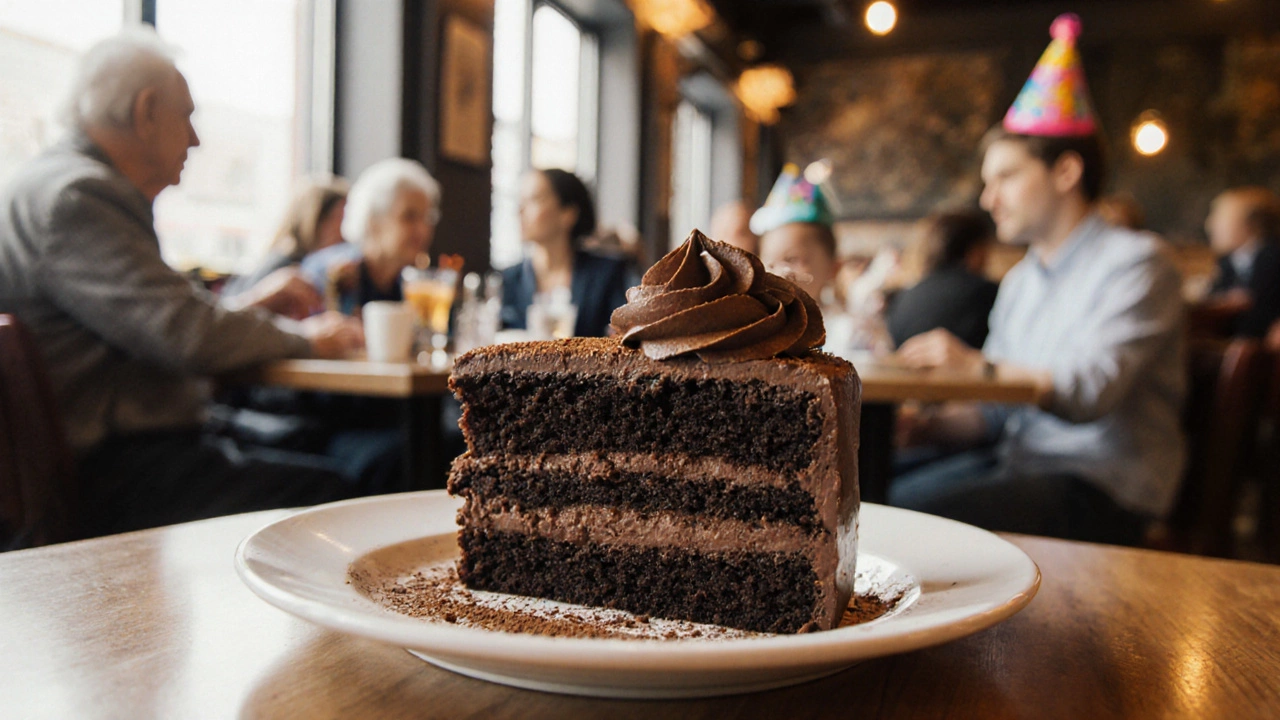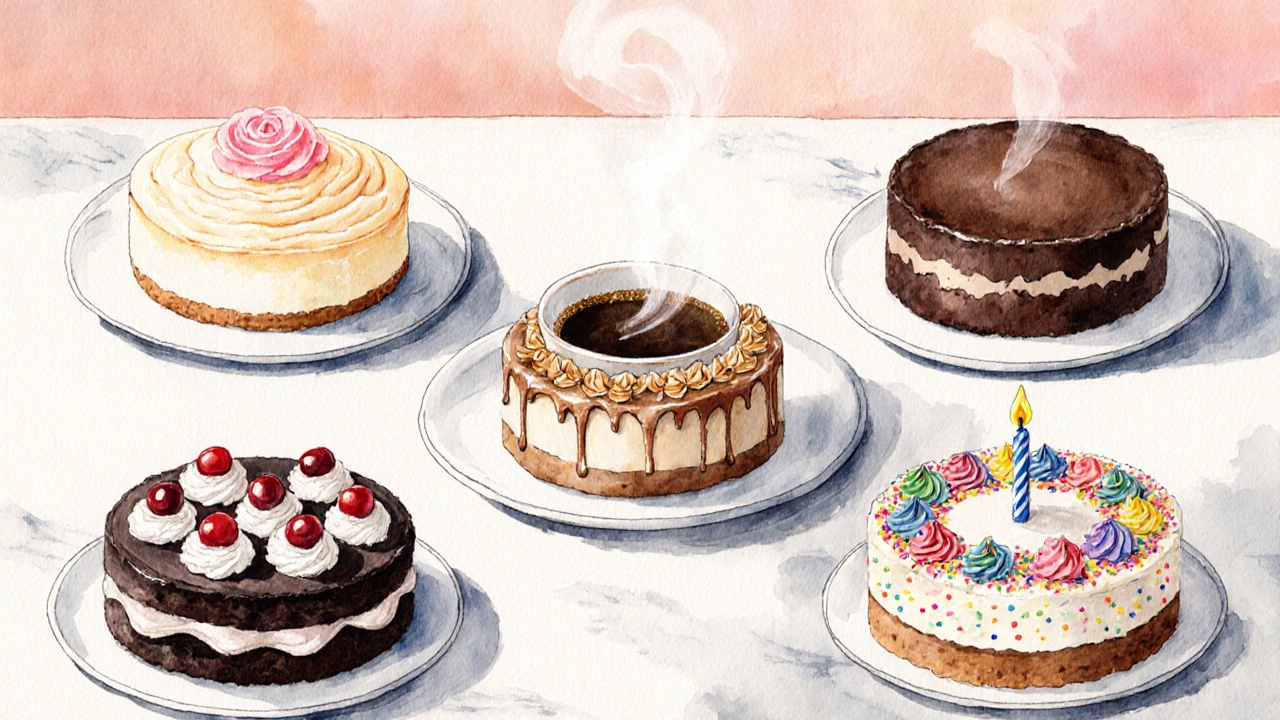Chocolate Cake Servings Calculator
Adjusted Ingredients
Based on standard recipe serving 12 people
- Flour: 0.00 cups
- Cocoa powder: 0.00 cups
- Baking soda: 0.00 tsp
- Salt: 0.00 tsp
- Butter: 0.00 cups
- Sugar: 0.00 cups
- Eggs: 0.00 large
- Vanilla extract: 0.00 tsp
- Buttermilk: 0.00 cups
- Melted chocolate: 0.00 cups
Ever wondered which cake gets the most slices around the planet? The answer isn’t a fancy French patisserie or a niche regional treat - it’s a classic that shows up on birthday parties, office celebrations, and family gatherings everywhere. In this deep‑dive we’ll uncover the data behind the most eaten cake title, compare the top contenders, and explain why certain flavors dominate in specific corners of the world.
How We Measured Global Cake Consumption
To rank cakes we combined three reliable sources:
- Annual sales reports from the world’s largest bakery chains (e.g., Dunkin’, Bake Cheese, and local supermarket bakeries).
- Consumer surveys conducted by market‑research firms such as Nielsen and Euromonitor covering over 150countries.
- Production statistics from major ingredient suppliers - cocoa, cream cheese, and wheat flour - which give a proxy for the volume of each cake type.
We then converted the data into estimated servings per year, adjusting for regional population size. The result is a clear picture of which cake truly tops the global leaderboard.
Top 5 Most Eaten Cakes Worldwide
Below is a quick look at the five cakes that dominate the global palate.
| Cake | Annual servings (billions) | Key regions | Signature ingredients |
|---|---|---|---|
| Chocolate cake is a rich, moist cake flavored with cocoa powder or melted chocolate, enjoyed worldwide | 3.8 | North America, Europe, Brazil, India | Cocoa, butter, sugar |
| Birthday cake a celebratory cake, often layered and decorated with frosting, candles, and personalized messages | 3.5 | Global (every culture) | Vanilla sponge, buttercream, fondant |
| Cheesecake a dense, creamy dessert made from cream cheese, eggs, and a crust, frequently flavored with fruit or chocolate | 2.1 | USA, Europe, Japan | Cream cheese, graham‑crack crust |
| Red velvet cake a moist cocoa‑based cake with a striking red crumb, typically finished with cream cheese frosting | 1.3 | USA, Canada, Australia | Cocoa, beetroot powder, buttermilk |
| Sponge cake a light, airy cake made by beating eggs and sugar to incorporate air, often used as a base for layered desserts | 1.0 | Europe, Latin America | Eggs, flour, sugar |
Why Chocolate Cake Leads the Pack
Chocolate cake’s reign isn’t a coincidence. Here are three concrete reasons that turn it into the global favorite:
- Universal appeal of chocolate: Scientific studies show that cocoa triggers dopamine release, giving a mood‑boosting effect that transcends cultural borders.
- Versatile recipe base: Whether a baker uses simple cocoa powder, melted dark chocolate, or a combination of both, the end result can be adjusted for sweetness, richness, or health‑consciousness (e.g., using avocado oil).
- Strong marketing history: From the iconic “Chocolate Cake Day” on social media to major chain promotions, the cake gets repeated exposure, reinforcing its popularity.
In Brazil, for example, a 2023 Nielsen report estimated that 42% of all bakery purchases were chocolate‑flavored cakes, driven by both festive celebrations and everyday coffee‑break treats.

Regional Flavor Trends
Even though chocolate cake is the clear leader, different regions have their own beloved picks. Below are a few notable patterns:
- East Asia: Japanese cheesecake - a soufflé‑like, lightly baked cake - accounts for 15% of bakery sales in major Japanese cities, thanks to its delicate texture and lower fat content.
- Middle East: Coffee cake infused with cardamom and Arabic coffee beans has surged, especially in urban cafés where the “coffee‑first” culture thrives.
- Southern United States: Black Forest cake, with its cherry‑laden layers and whipped‑cream topping, dominates holiday menus, driven by nostalgia and the region’s love for fruit‑filled desserts.
These trends illustrate that while a single cake can dominate globally, local palates still shape the market in meaningful ways.
Key Ingredients That Drive Global Consumption
Understanding what makes a cake popular also means looking at the building blocks. Below are the most common ingredients across the top five cakes and why they matter:
| Ingredient | Role | Global Availability |
|---|---|---|
| Cocoa powder | Provides chocolate flavor and color | Widely exported from West Africa, Brazil, and Indonesia |
| Butter | Creates richness and tender crumb | Produced in dairy‑rich regions; substituteable with oils |
| Cream cheese | Gives cheesecake its signature density | Manufactured globally, with strong markets in USA and Europe |
| Eggs | Levitates sponge and provides structure | Universal, but price fluctuations affect bakery pricing |
| Flour (wheat) | Primary structural component | Staple crop; gluten‑free alternatives impact niche markets |
When an ingredient is inexpensive and easy to source, bakeries can produce the cake at scale, which directly feeds into higher consumption numbers.

How Culture Shapes Cake Choices
Beyond taste, cakes are symbols. In many cultures, a cake marks a rite of passage - birthdays, graduations, and weddings. The Birthday cake a celebratory cake, often layered and decorated with frosting, candles, and personalized messages therefore appears in almost every household, inflating its consumption figures even if the flavor varies.
Similarly, the rise of Instagram‑friendly aesthetics has boosted cakes that photograph well, such as the towering Red Velvet or the glossy Black Forest. The visual factor adds a marketing layer that pure taste alone can’t explain.
Quick Tips: Baking the World’s Favorite Cake at Home
If you want to join the billions who enjoy a slice, here’s a proven recipe that mirrors the commercial‑grade chocolate cake you’ll find in a bakery.
- Pre‑heat oven to 350°F (175°C). Grease two 9‑inch round pans.
- Combine 1¾cups all‑purpose flour, ¾cup cocoa powder, 2tsp baking soda, and ½tsp salt.
- In a separate bowl, beat 1cup softened butter with 2cups sugar until light.
- Add 2large eggs one at a time, then 1tsp vanilla extract.
- Alternate adding the dry mix and 1cup buttermilk, starting and ending with dry ingredients.
- Stir in ½cup melted dark chocolate for extra depth.
- Divide batter, bake 30‑35minutes, then cool completely.
- Frost with a simple chocolate buttercream: butter, powdered sugar, cocoa, and a splash of espresso.
These steps yield a moist, rich slice that mirrors the taste profile driving its global dominance.
Frequently Asked Questions
Which cake is the most popular for birthdays?
While flavor preferences differ, the classic vanilla‑layered Birthday cake remains the most requested cake for birthday celebrations worldwide.
Is chocolate cake healthier than other cakes?
Not necessarily. Chocolate adds antioxidants, but most commercial recipes are high in sugar and butter. Opt for dark chocolate and reduce added sugars to make it a bit healthier.
How does regional cuisine affect cake popularity?
Local ingredients, festivals, and cultural symbolism all steer preferences. For example, Japanese cheesecake’s light texture aligns with the country’s love for delicate desserts, while coffee‑infused cakes thrive in the Middle East where coffee culture is strong.
Can I make a gluten‑free version of the world’s most eaten cake?
Absolutely. Substitute the wheat flour with a blend of rice flour, almond flour, and xanthan gum. The texture changes slightly, but the chocolate flavor remains front‑and‑center.
Where can I find reliable data on global cake consumption?
Look at market‑research firms like Euromonitor, Nielsen, and the International Cocoa Organization. Their yearly reports break down sales by product category and region, which we used for this analysis.